Collaborative Integrated Sustainable Tourism Management Model Using System Dynamics: A Case of Labuan Bajo, Indonesia
Abstract
:1. Introduction
2. Literature Review
3. Materials and Methods
3.1. Case Study
3.2. Methodology
3.3. System Dynamics Modeling
3.3.1. System Observation
3.3.2. Compilation of the Problem Structure
3.3.3. Modeling
3.3.4. Model Validation
3.3.5. Simulation of Business-as-Usual Model
3.3.6. Simulation of the Intervention Scenario
3.3.7. Interpretation and Use of Model Simulation Results
4. Results
4.1. Causal-Loop Diagram
4.2. Stock-and-Flow Diagram
4.3. Model Validation
- For the number of Tourist Visits, each AME value is 28% for foreign tourists, 28% for domestic tourists, and 27% for total tourists. The tourist visits models are declared valid.
- For the number of Hotel Rooms and Boat Rooms, each AME value is 0.16% for hotel rooms and 13% for boat rooms. The Hotel Rooms and Boat Rooms models are declared valid.
- For GRDP, Poverty Rate, and West Manggarai HDI, each AME value is 0.17% for GRDP, 9% for poverty, and 3% for HDI. The GRDP, Poverty Rate, and HDI models are declared valid.
- For food production in West Manggarai Regency, AME values were 7% for rice, 20% for fish, 10% for meat, and 11% for vegetables and fruit. The food production models are declared valid.
4.4. Business-as-Usual Model Simulation
5. Discussion
6. Conclusions
Author Contributions
Funding
Institutional Review Board Statement
Informed Consent Statement
Data Availability Statement
Acknowledgments
Conflicts of Interest
References
- Central Bureau of Statistics of West Manggarai Regency. West Manggarai Numbers 2020, 2020, 181.
- Ardiantiono; Jessop, T.S.; Purwandana, D.; Ciofi, C.; Imansyah, M.J.; Panggur, M.R.; Ariefiandy, A. Effects of human activities on Komodo dragons in Komodo National Park. Biodivers. Conserv. 2018, 27, 3329–3347. [Google Scholar] [CrossRef]
- Ariefiandy, A.; Purwandana, D.; Benu, Y.J.; Letnic, M.; Jessop, T.S. Knee deep in trouble: Rusa deer use an aquatic escape behaviour to delay attack by Komodo dragons. Aust. Mammal. 2019, 42, 103–105. [Google Scholar] [CrossRef]
- Ariefiandy, A.; Purwandana, D.; Natali, C.; Imansyah, M.J.; Surahman, M.; Jessop, T.S.; Ciofi, C. Conservation of Komodo dragons Varanus komodoensis in the Wae Wuul nature reserve, Flores, Indonesia: A multidisciplinary approach. Int. Zoo Yearb. 2015, 49, 67–80. [Google Scholar] [CrossRef]
- Jessop, T.S.; Ariefiandy, A.; Purwandana, D.; Ciofi, C.; Imansyah, J.; Benu, Y.J.; Fordham, D.A.; Forsyth, D.M.; Mulder, R.A.; Phillips, B.L. Exploring mechanisms and origins of reduced dispersal in island Komodo dragons. Proc. R. Soc. B Biol. Sci. 2018, 285, 20181829. [Google Scholar] [CrossRef] [Green Version]
- Jessop, T.S.; Madsen, T.; Ciofi, C.; Imansyah, M.J.; Purwandana, D.; Rudiharto, H.; Arifiandy, A.; Phillips, J.A. Island differences in population size structure and catch per unit effort and their conservation implications for Komodo dragons. Biol. Conserv. 2007, 135, 247–255. [Google Scholar] [CrossRef]
- Ministry of Environment and Forestry Republic of Indonesia. Komodo National Park 25 Year Management Plan; Ministry of Environment and Forestry Republic of Indonesia: Labuan Bajo, Indonesia, 2000.
- Kennedi, U.F.; Kusrini, M.D.; Ariefiandy, A.; Mardiastuti, A. Invasive toads are close to but absent from Komodo National Park. BIO Web. Conf. 2020, 19, 00017. [Google Scholar] [CrossRef] [Green Version]
- Ministry of Environment and Forestry Republic of Indonesia. Komodo National Park Management Plan 2016–2025; Ministry of Environment and Forestry Republic of Indonesia: Labuan Bajo, Indonesia, 2016.
- Dushani, S.N.; Aanesen, M.; Vondolia, G.K. Balancing conservation goals and ecotourism development in coastal wetland management in Sri Lanka: A choice experiment. Ocean Coast. Manag. 2021, 210, 105659. [Google Scholar] [CrossRef]
- García-Jiménez, R.; Morales-Reyes, Z.; Pérez-García, J.M.; Margalida, A. Economic valuation of non-material contributions to people provided by avian scavengers: Harmonizing conservation and wildlife-based tourism. Ecol. Econ. 2021, 187, 107088. [Google Scholar] [CrossRef]
- Gonzáles-Mantilla, P.G.; Gallagher, A.J.; León, C.J.; Vianna, G.M.S. Challenges and conservation potential of shark-diving tourism in the Macaronesian archipelagos. Mar. Policy 2021, 131, 104632. [Google Scholar] [CrossRef]
- Zhou, W.; Zheng, B.; Zhang, Z.-Q.; Song, Z.-J.; Duan, W. The role of eco-tourism in ecological conservation in giant panda nature reserve. J. Environ. Manag. 2021, 295, 113077. [Google Scholar] [CrossRef]
- Muntifering, J.R.; Clark, S.; Linklater, W.L.; Uri-Khob, S.; Hebach, E.; Cloete, J.; Jacobs, S.; Knight, A.T. Lessons from a conservation and tourism cooperative: The Namibian black rhinoceros case. Ann. Tour. Res. 2020, 82, 102918. [Google Scholar] [CrossRef]
- Tanalgo, K.C.; Hughes, A.C. The potential of bat-watching tourism in raising public awareness towards bat conservation in the Philippines. Environ. Chall. 2021, 4, 100140. [Google Scholar] [CrossRef]
- Warne, S.J.; Thompson, M. Future approaches to evaluating tourism in the developing world: Assessing realism in the Solomon Islands. J. Hosp. Tour. Manag. 2022, 50, 391–399. [Google Scholar] [CrossRef]
- Wang, J.; Huang, X.; Gong, Z.; Cao, K. Dynamic assessment of tourism carrying capacity and its impacts on tourism economic growth in urban tourism destinations in China. J. Destin. Mark. Manag. 2020, 15, 100383. [Google Scholar] [CrossRef]
- Wang, W.C.; Lin, C.H. A model for sustainable tourism development of hot spring destinations following poverty alleviation: Understanding the tourists’ perspective. Sustainability 2021, 13, 9856. [Google Scholar] [CrossRef]
- Bahja, F.; Hancer, M. Eco-guilt in tourism: Do tourists intend to behave environmentally friendly and still revisit? J. Destin. Mark. Manag. 2021, 20, 100602. [Google Scholar] [CrossRef]
- Insch, A. The challenges of over-tourism facing New Zealand: Risks and responses. J. Destin. Mark. Manag. 2020, 15, 100378. [Google Scholar] [CrossRef]
- Zhang, S.; Chan, E.S.W. A modernism-based interpretation of sustainable tourism. Int. J. Tour. Res. 2020, 22, 223–237. [Google Scholar] [CrossRef]
- Gkoumas, A. Evaluating a standard for sustainable tourism through the lenses of local industry. Heliyon 2019, 5, e02707. [Google Scholar] [CrossRef]
- Grilli, G.; Tyllianakis, E.; Luisetti, T.; Ferrini, S.; Turner, R.K. Prospective tourist preferences for sustainable tourism development in Small Island Developing States. Tour. Manag. 2021, 82, 1041178. [Google Scholar] [CrossRef]
- Diesendorf, M.; Hamilton, C. Human Ecology, Human Economy: Ideas for an Ecologically Sustainable Future; Allen & Unwin: St. Leonards, Australia, 1997. [Google Scholar]
- Pan, S.Y.; Gao, M.; Kim, H.; Shah, K.J.; Pei, S.L.; Chiang, P.C. Advances and challenges in sustainable tourism toward a green economy. Sci. Total Environ. 2018, 635, 452–469. [Google Scholar] [CrossRef] [PubMed]
- Sheller, M. Reconstructing tourism in the Caribbean: Connecting pandemic recovery, climate resilience and sustainable tourism through mobility justice. J. Sustain. Tour. 2020, 29, 1436–1449. [Google Scholar] [CrossRef]
- Schoneveld, G.C. Sustainable business models for inclusive growth: Towards a conceptual foundation of inclusive business. J. Clean. Prod. 2020, 277, 124062. [Google Scholar] [CrossRef]
- Valdivia, S.; Ugaya, C.M.L.; Hildenbrand, J.; Traverso, M.; Mazijn, B.; Sonnemann, G. A UNEP/SETAC approach towards a life cycle sustainability assessment—Our contribution to Rio+20. Int. J. Life Cycle Assess. 2013, 18, 1673–1685. [Google Scholar] [CrossRef]
- Andereck, K.L.; Nyaupane, G.P. Exploring the Nature of Tourism and Quality of Life Perceptions among Residents. J. Travel Res. 2011, 50, 248–260. [Google Scholar] [CrossRef]
- Camargo, B.A.; Winchenbach, A.; Vázquez-Maguirre, M. Restoring the dignity of indigenous people: Perspectives on tourism employment. Tour. Manag. Perspect. 2022, 41, 100946. [Google Scholar] [CrossRef]
- Gyawali, P.; Bhandari, S.; Shrestha, J. Horti-tourism; an approach for strengthening farmers’ economy in the post-covid situation. J. Agric. Food Res. 2022, 7, 100278. [Google Scholar] [CrossRef]
- An, H.M.; Xiao, C.D.; Tong, Y.; Fan, J. Ice-and-snow tourism and its sustainable development in China: A new perspective of poverty alleviation. Adv. Clim. Chang. Res. 2021, 12, 881–893. [Google Scholar] [CrossRef]
- Pan, Y.; Wang, X.; Ryan, C. Chinese seniors holidaying, elderly care, rural tourism and rural poverty alleviation programmes. J. Hosp. Tour. Manag. 2021, 46, 134–143. [Google Scholar] [CrossRef]
- Higgins-Desbiolles, F. The “war over tourism”: Challenges to sustainable tourism in the tourism academy after COVID-19. J. Sustain. Tour. 2020, 29, 551–569. [Google Scholar] [CrossRef]
- Zhang, J. The effects of tourism on income inequality: A meta-analysis of econometrics studies. J. Hosp. Tour. Manag. 2021, 48, 312–321. [Google Scholar] [CrossRef]
- Pham, T.T.T. Tourism in marine protected areas: Can it be considered as an alternative livelihood for local communities? Mar. Policy 2020, 115, 103891. [Google Scholar] [CrossRef]
- Lee, C.C.; Chen, M.P. Ecological footprint, tourism development, and country risk: International evidence. J. Clean. Prod. 2021, 279, 123671. [Google Scholar] [CrossRef]
- Shi, Y.; Shi, S.; Wang, H. Reconsideration of the methodology for estimation of land population carrying capacity in Shanghai metropolis. Sci. Total Environ. 2019, 652, 367–381. [Google Scholar] [CrossRef]
- Virtanen, P.K.; Siragusa, L.; Guttorm, H. Introduction: Toward more inclusive definitions of sustainability. Curr. Opin. Environ. Sustain. 2020, 43, 77–82. [Google Scholar] [CrossRef]
- Visseren-Hamakers, I.J.; Razzaque, J.; McElwee, P.; Turnhout, E.; Kelemen, E.; Rusch, G.M.; Fernández-Llamazares, A.; Chan, I.; Lim, M.; Islar, M.; et al. Transformative governance of biodiversity: Insights for sustainable development. Curr. Opin. Environ. Sustain. 2021, 53, 20–28. [Google Scholar] [CrossRef]
- Dimitrovski, D.; Lemmetyinen, A.; Nieminen, L.; Pohjola, T. Understanding coastal and marine tourism sustainability—A multi-stakeholder analysis. J. Destin. Mark. Manag. 2021, 19, 100554. [Google Scholar] [CrossRef]
- Ahmad, R.; Nurmawati, K.M.; Kodir, A. Air dan konflik: Studi ketersediaan sumber daya air di kawasan taman nasional Komodo. J. Ilmu Sos. dan Hum. 2021, 10, 337–350. [Google Scholar] [CrossRef]
- Kodir, A.; Tanjung, A.; Astina, I.K.; Nurwan, M.A.; Nusantara, A.G.; Ahmad, R. The Dynamics of Access on Tourism Development in Labuan Bajo, Indonesia. Geoj. Tour. Geosites 2020, 29, 662–671. [Google Scholar] [CrossRef]
- Mai, T.; Smith, C. Scenario-based planning for tourism development using system dynamic modelling: A case study of Cat Ba Island, Vietnam. Tour. Manag. 2018, 68, 336–354. [Google Scholar] [CrossRef]
- Hosseini, K.; Stefaniec, A.; Hosseini, S.P. World Heritage Sites in developing countries: Assessing impacts and handling complexities toward sustainable tourism. J. Destin. Mark. Manag. 2021, 20, 100616. [Google Scholar] [CrossRef]
- Sweeney, L.B.; Sterman, J.D. Bathtub dynamics: Initial results of a systems thinking inventory. Syst. Dyn. Rev. 2000, 16, 249–286. [Google Scholar]
- Miller, G.T.; Spoolman, S.E. Environmental Science, 15th ed.; Cengange Learning: Boston, MA, USA, 2016. [Google Scholar]
- Martínez, J.M.G.; Martín, J.M.M.; Fernández, J.A.S.; Mogorrón-Guerrero, H. An analysis of the stability of rural tourism as a desired condition for sustainable tourism. J. Bus. Res. 2019, 100, 165–174. [Google Scholar] [CrossRef]
- Mai, T.; Smith, C. Addressing the threats to tourism sustainability using systems thinking: A case study of Cat Ba Island, Vietnam. J. Sustain. Tour. 2015, 23, 1504–1528. [Google Scholar] [CrossRef]
- Utami, T.N.; Fattah, M.; Intyas, C.A. The System Dynamic of Mangrove Ecotourism of “Kampung Blekok” Situbondo East Java Indonesia: Economic and Ecological Dimension. Environ. Res. Eng. Manag. 2022, 78, 58–72. [Google Scholar] [CrossRef]
- Santoso, S.; Widyanty, W.; Nurhidajat, R.; Marfatah, M.R.; Mahmud, G.; Fahlevi, M.; Aljuaid, M.; Zhghenti, T.; Shahid, D. System dynamics modeling for developing an agrotourism-creative economy in the framework of the village innovation system. Front. Environ. Sci. 2022, 10, 962235. [Google Scholar] [CrossRef]
- Luo, Y.; Mou, Y.; Wang, Z.; Su, Z.; Qin, Y. Scenario-based planning for a dynamic tourism system with carbon footprint analysis: A case study of Xingwen Global Geopark, China. J. Clean. Prod. 2020, 254, 119999. [Google Scholar] [CrossRef]
- Wang, L.; Wang, R.; Yan, H. System-dynamics modeling for exploring the impact of industrial-structure adjustment on the water quality of the river network in the Yangtze Delta Area. Sustainability 2021, 13, 7696. [Google Scholar] [CrossRef]
- Sedarati, P.; Santos, S.; Pintassilgo, P. System Dynamics in Tourism Planning and Development. Tour. Plan. Dev. 2019, 16, 256–280. [Google Scholar] [CrossRef]
- Muchtar, F.S.; Hasibuan, H.S.; De Rozari, P. Land management semi-arid archipelago based on water carrying capacity: Studies on Labuan Bajo, East Nusa Tenggara. J. Degrad. Min. Lands Manag. 2023, 10, 4647–4658. [Google Scholar] [CrossRef]
- Cole, S. Water worries: An intersectional feminist political ecology of tourism and water in Labuan Bajo, Indonesia. Ann. Tour. Res. 2017, 67, 14–24. [Google Scholar] [CrossRef]
- Reindrawati, D.Y.; Rhama, B.; Hisan, U.F.C. Threats to Sustainable Tourism in National Parks: Case Studies from Indonesia and South Africa. Afr. J. Hosp. Tour. Leis. 2022, 11, 919–937. [Google Scholar]
- Yudhoyono, E.B.; Siregar, H.; Achsani, N.A.; Irawan, T. Financial Performance of Tourism Businesses in Labuan Bajo Tourist Area. Indonesia. J. Environ. Manag. Tour. 2021, 12, 458–465. [Google Scholar] [CrossRef] [PubMed]
- Sianipar, I.M.J.; Tehupeiory, A.; Maya, A.J.; Huy, H.L.A.; Tuan, H.Q.; Suryawan, I.W.K. Human Ecosystem Approach to The Dynamics of Sustainable Development in Komodo National Park, Indonesia. J. Gov. Civ. Soc. 2022, 6, 276–291. [Google Scholar]
- Benu, F.; Muskanan, M.W.; King, P.G.; Asa, H.M.; Wulakada, H.H. Issue 2 Spring. J. Environ. Manag. Tour. 2020, XI, 250–262. [Google Scholar] [CrossRef]
- Islahuddin, I.; Eppang, B.M.; Som, A.P.M.; Masatip, A.; Salim, M.A.M. Adaptation and collaboration of local community in super priority destination tourism program in Labuan Bajo. ETNOSIA J. Etnogr. Indones. 2022, 7, 15–28. [Google Scholar] [CrossRef]
- Wibowo, M. Modeling the Potential of Tsunami Hazard in Labuan Bajo Towards A Disaster-Resilient Tourism Area. Indones. J. Geogr. 2022, 54, 83–91. [Google Scholar] [CrossRef]
- Muhammadi; Aminullah, E.; Soesilo, B. System Dynamics Analysis: Environmental, Social, Economic, Management, 1st ed.; UMJ Press: Jakarta, Indonesia, 2001; Volume 1. [Google Scholar]
- Soesilo, B.; Karuniasa, M. Permodelan Sistem Dinamis, 1st ed.; Lembaga Penerbit Fakultas Ekonomi Universitas Indonesia: Jakarta, Indonesia, 2014; Volume 1. [Google Scholar]
- Husain; Zarlis, M.; Mawengkang, H.; Efendi, S. Causal Loop Diagram (CLD) Model in Planning A Sustainable Smart Sharia Tourism. J. Phys Conf. Ser. 2020, 1641, 012099. [Google Scholar] [CrossRef]
- Komodo National Park Office. Visitors of Komodo National Park Office 2010–2022; Komodo National Park Office: Labuan Bajo, Indonesia, 2022. [Google Scholar]
- West Manggarai Cultural Creative Economy and Tourism Office. West Manggarai Regency Visitor Satisfaction Exit Survey 2022; West Manggarai Cultural Creative Economy and Tourism Office: Labuan Bajo, Indonesia, 2022.
- West Manggarai Cultural Creative Economy and Tourism Office. West Manggarai Regency Tourism Data 2022; West Manggarai Cultural Creative Economy and Tourism Office: Labuan Bajo, Indonesia, 2022.
- Ministry of Public Works and Housing Republic of Indonesia, 2022. Integrated Tourism Master Plan Komodo National Park and Labuan Bajo; Ministry of Public Works and Housing: Jakarta, Indonesia, 2022.
- West Manggarai Regional Water Company. West Manggarai Regency Water Service Data 2022; West Manggarai Regional Water Company: Labuan Bajo, Indonesia, 2022. [Google Scholar]
- Obersteiner, G.; Gollnow, S.; Eriksson, M. Carbon footprint reduction potential of waste management strategies in tourism. Environ. Dev. 2021, 39, 100617. [Google Scholar] [CrossRef]
- Ariyani, N.; Fauzi, A. Pathways toward the Transformation of Sustainable Rural Tourism Management in Central Java, Indonesia. Sustainability 2023, 15, 2592. [Google Scholar] [CrossRef]
- Wondirad, A.; Tolkach, D.; King, B. Stakeholder collaboration as a major factor for sustainable ecotourism development in developing countries. Tour. Manag. 2020, 78, 104024. [Google Scholar] [CrossRef]
- Hothi, N.; Hothi, G. Water crisis of Shimla Town: Past and present scenario. Mater. Today Proc. 2022, 64, 1250–1254. [Google Scholar] [CrossRef]
- Pizzitutti, F.; Walsh, S.J.; Rindfuss, R.R.; Gunter, R.; Quiroga, D.; Tippett, R.; Mena, C.F. Scenario planning for tourism management: A participatory and system dynamics model applied to the Galapagos Islands of Ecuador. J. Sustain. Tour. 2017, 25, 1117–1137. [Google Scholar] [CrossRef]
- Lee, T.H.; Jan, F.H.; Liu, J.T. Developing an indicator framework for assessing sustainable tourism: Evidence from a Taiwan ecological resort. Ecol. Indic. 2021, 125, 107596. [Google Scholar] [CrossRef]
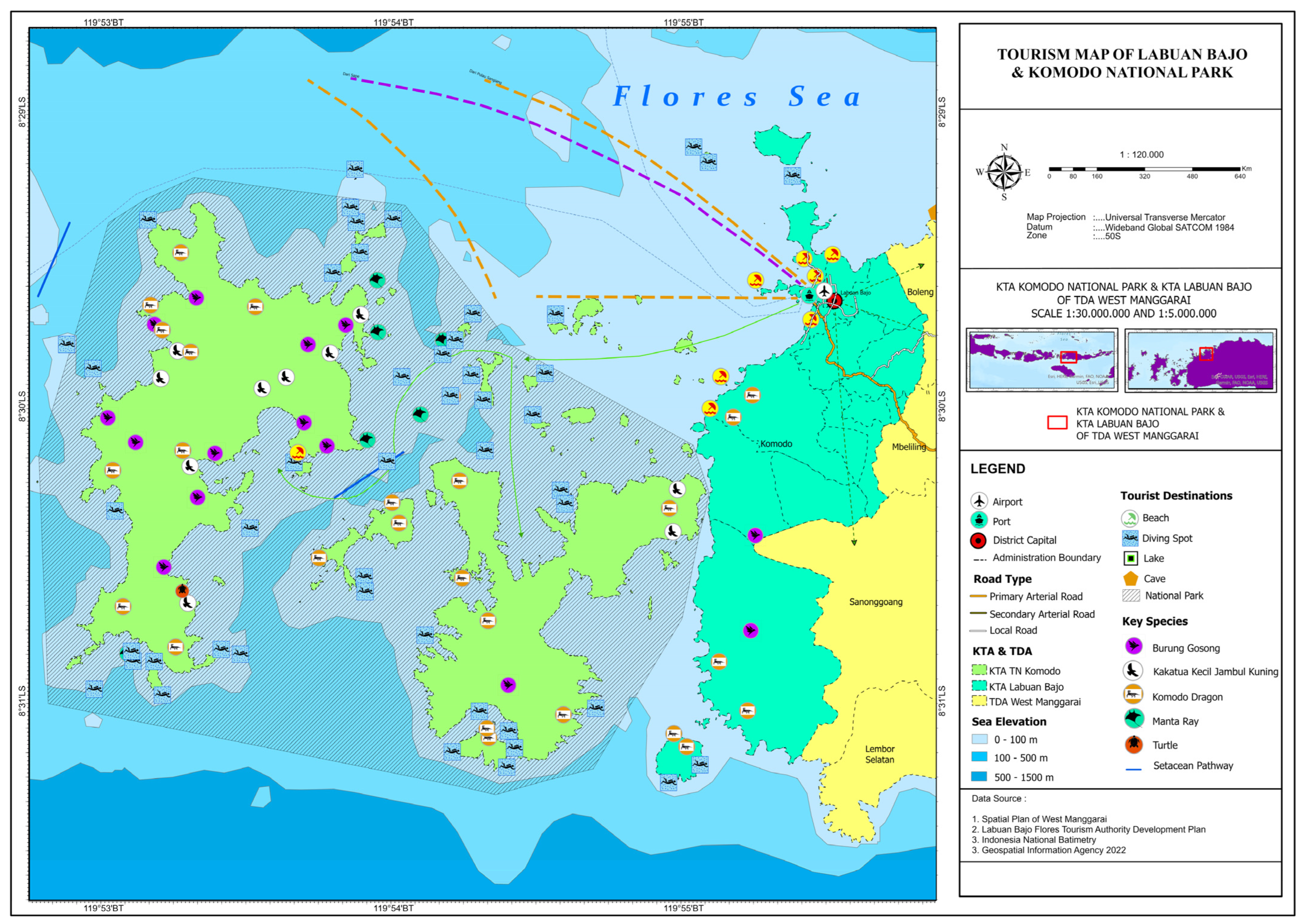
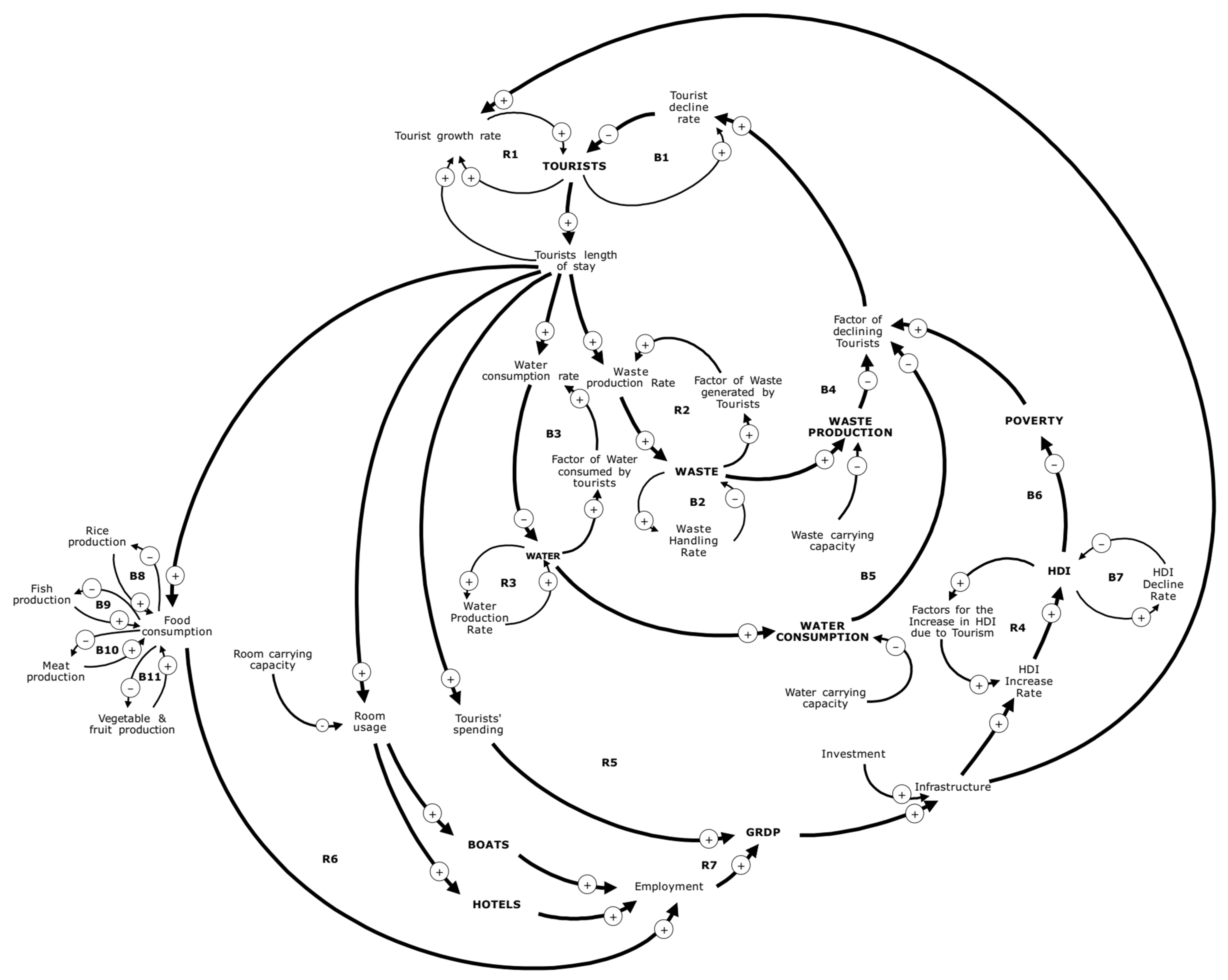
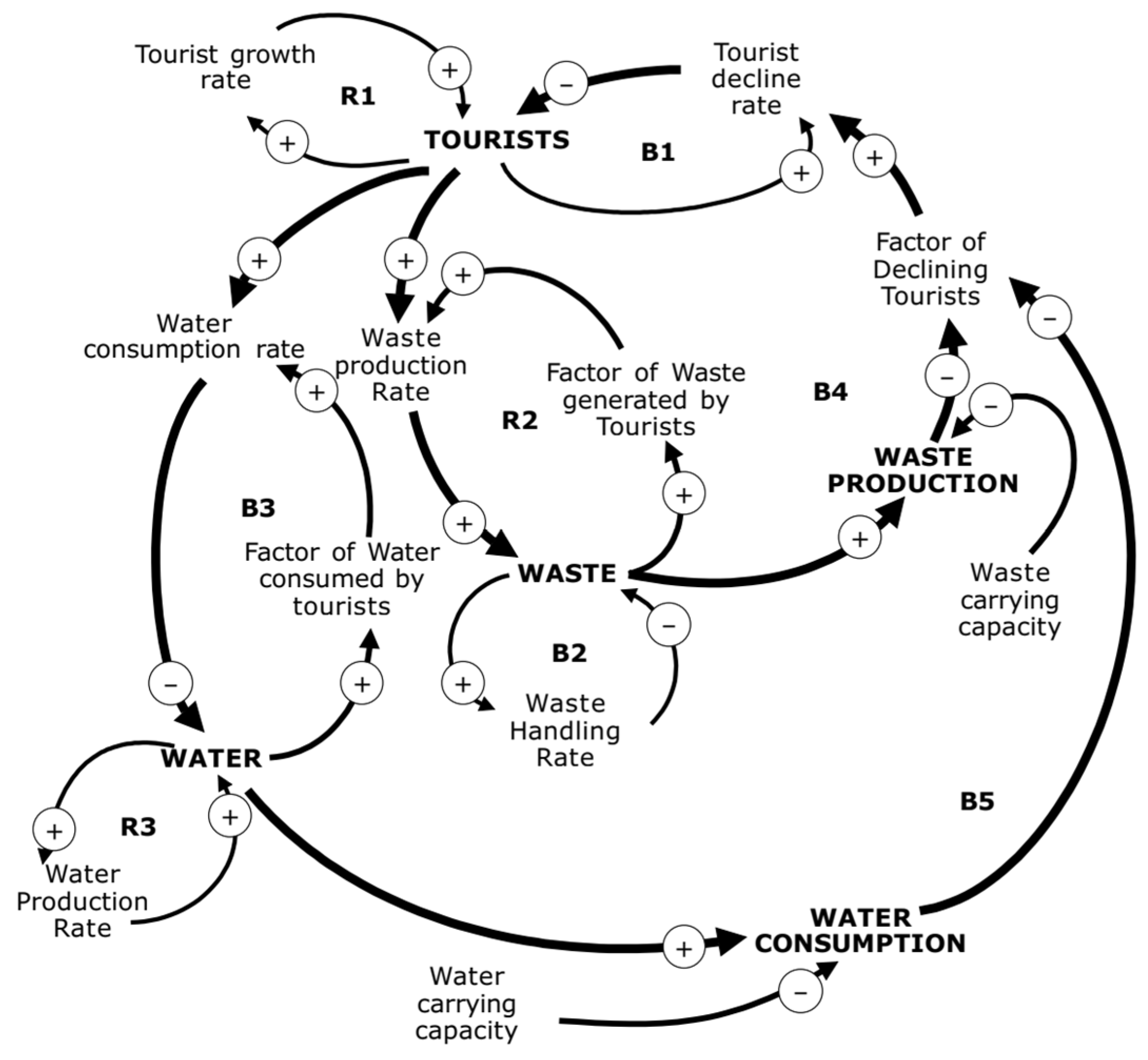
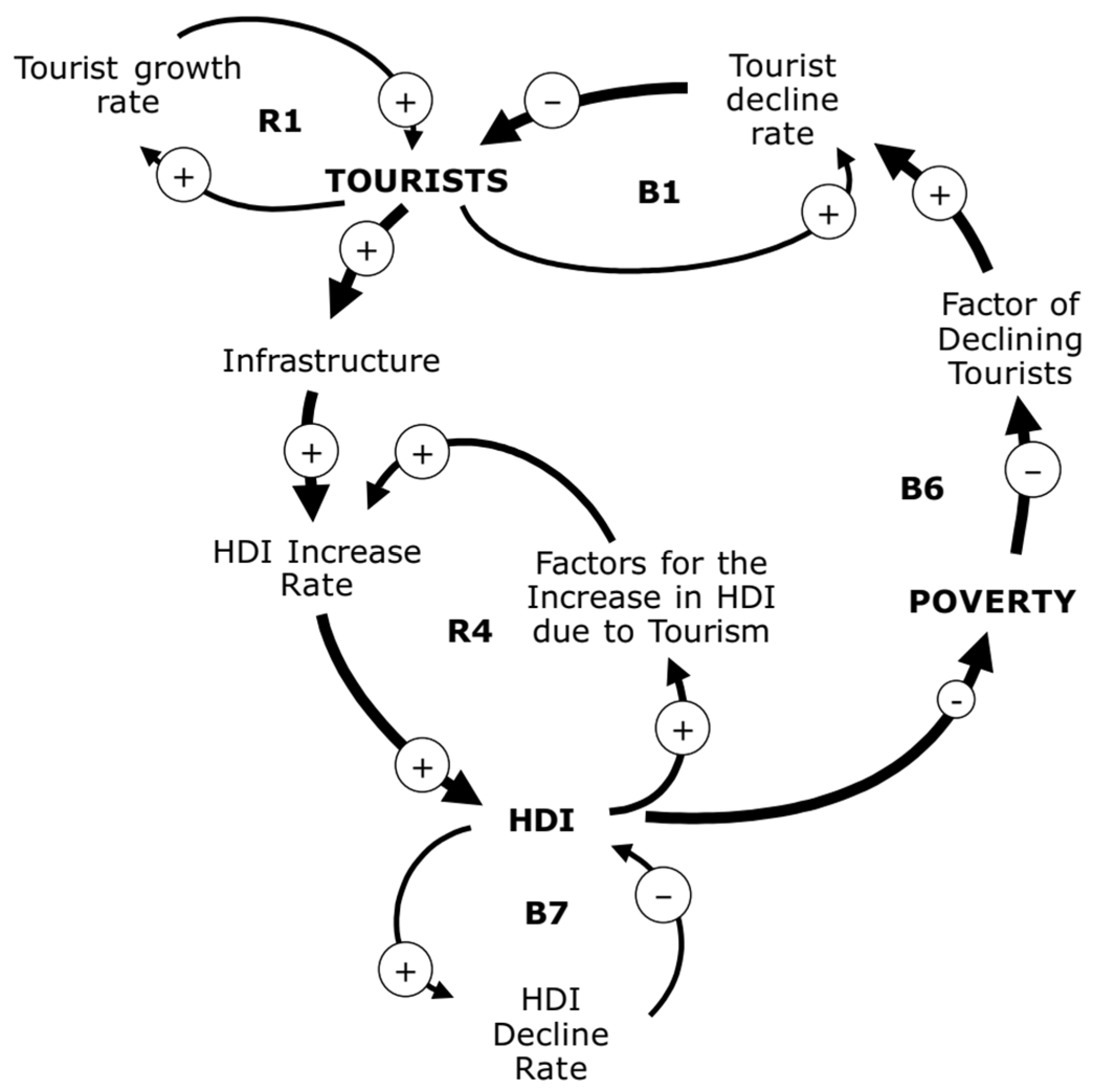











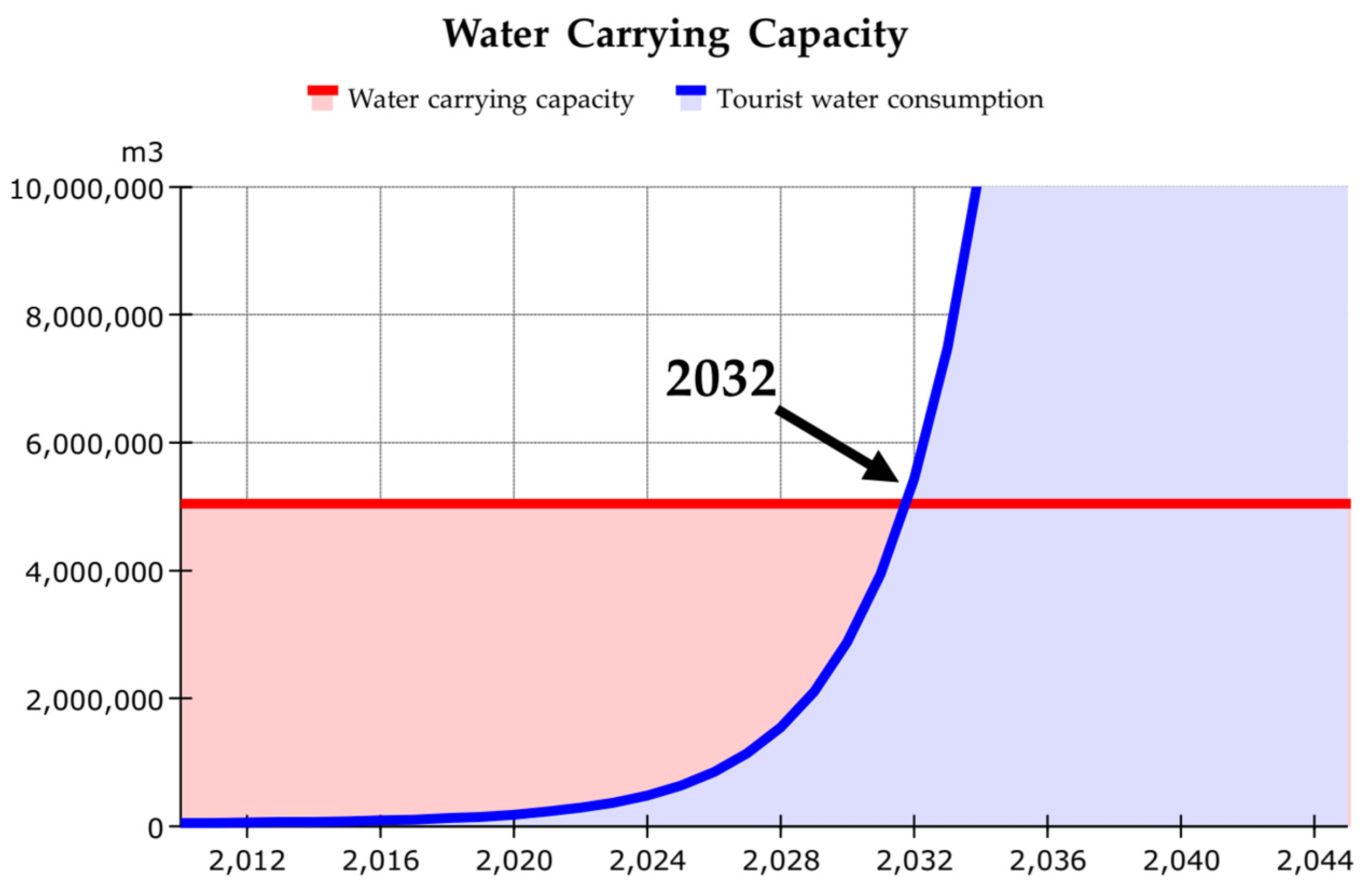




| Muhammadi et al. [63] | Soesilo & Karuniasa [64] |
|---|---|
|
|
|
|
|
|
|
|
|
|
|
| Subsystem | Specific Key Parameters | Unit |
|---|---|---|
| Tourism Visit | Tourist visits | persons |
| Tourist length of stay | days | |
| Tourist spending | IDR | |
| Tourism carrying capacity | persons/year | |
| Environment | Domestic water consumption | litres/person/day |
| Tourism water consumption | litres/bed/day | |
| Water supply capacity | m3/year | |
| Water needs | m3/year | |
| Waste production | ton/day | |
| Tourist waste generation | kg/day | |
| Waste management capacity | ton/year | |
| Social | Infrastructure | dimensionless |
| Workforce | persons | |
| Poverty | persons | |
| Human Development Index | dimensionless | |
| Economy | GRDP | IDR |
| Investment | IDR | |
| Number of hotels | units | |
| Number of hotel rooms | rooms | |
| Number of boats | units | |
| Number of boat rooms | rooms | |
| Rice production | ton | |
| Fish production | ton | |
| Meat production | ton | |
| Vegetable and fruit production | ton |
| Domestic | Foreigner | |
|---|---|---|
| Average length of stay (days) | 5.25 | 4.52 |
| Average spending (IDR) | 9,604,116 | 10,697,187 |
| Average spending on souvenirs (IDR) | 1,853,776 | 1,399,445 |
| Percentage of tourists shopping souvenirs (%) | 73 | 42 |
| Year | Number of Tourist Boats (Unit) | Growth | Number of Rooms (Rooms) | Growth |
|---|---|---|---|---|
| 2016 | 90 | 247 | ||
| 2018 | 76 | −18% | 304 | 19% |
| 2020 | 126 | 40% | 537 | 43% |
| Average 2016–2020 | 11% | 31% | ||
| Unit | ||
|---|---|---|
| Domestic water consumption | 120 | litres/person/day |
| Leak tolerance | 20 | % |
| Tourist water consumption (SNI. 03-7065-2005) | 250 | litres/bed/day |
| Labuan Bajo urban water supply system capacity | 160 | litres/second |
| 5,045,760 | m3/year | |
| Total surface water flow | 260,996,054 | m3/year |
| Average runoff coefficient of runoff in Komodo district | 0.397 | |
| Total domestic, non-domestic, and tourist water needs | 5,760,280.35 | m3/year |
| Source | Unit | Generation (kg/Unit.Day) | Volume (litres/Unit.Day) |
|---|---|---|---|
| KTA Komodo National Park | |||
| Household waste | |||
| Komodo Village | person | 0.13 | 2.43 |
| Pasir Panjang Village | person | 0.13 | 2.43 |
| Papagarang Village | person | 0.13 | 2.43 |
| Total household waste | 0.39 | 7.29 | |
| Non-household waste | |||
| Loh Liang tourism | tourist | 0.02 | 0.5 |
| Loh Buaya tourism | tourist | 0.02 | 0.5 |
| Padar tourism | tourist | 0.02 | 0.5 |
| Total non-household waste | 0.06 | 1.5 | |
| Total KTA KNP waste | 0.45 | 8.79 | |
| KTA Labuan Bajo | |||
| Households | person | 0.3 | 2.5 |
| Medical facilities | bed | 0.6 | 7.7 |
| Restaurant | chair | 1.6 | 9.2 |
| Market | m2 | 0.1 | 0.6 |
| Hotel | bed | 0.1 | 1.9 |
| Office | employee | 0.1 | 7.9 |
| Store | employee | 0.3 | 0.5 |
| School | student | 0.0 | 0.2 |
| Boats | passenger | 0.6 | 8.8 |
| Road access | m | 0.025 | 0.1 |
| Total household waste | 0.3 | 2.5 | |
| Total non-household waste | 3.425 | 36.9 | |
| Total KTA Labuan Bajo waste | 3.725 | 39.4 |
| Unit | ||
|---|---|---|
| Tourist waste generation [71] | 1.67 | kg/person/day |
| Hotel and restaurant | 1.783 | ton/day |
| Tourist boats | 0.2 | ton/day |
| KTA Labuan Bajo waste generation [69] | 3.725 | kg/day |
| Total Labuan Bajo waste in 2020 [69] | 37,104.59 | Ton |
| Labuan Bajo waste management capacity by 2020 | 0.397 | ton/year |
Disclaimer/Publisher’s Note: The statements, opinions and data contained in all publications are solely those of the individual author(s) and contributor(s) and not of MDPI and/or the editor(s). MDPI and/or the editor(s) disclaim responsibility for any injury to people or property resulting from any ideas, methods, instructions or products referred to in the content. |
© 2023 by the authors. Licensee MDPI, Basel, Switzerland. This article is an open access article distributed under the terms and conditions of the Creative Commons Attribution (CC BY) license (https://creativecommons.org/licenses/by/4.0/).
Share and Cite
Fatina, S.; Soesilo, T.E.B.; Tambunan, R.P. Collaborative Integrated Sustainable Tourism Management Model Using System Dynamics: A Case of Labuan Bajo, Indonesia. Sustainability 2023, 15, 11937. https://doi.org/10.3390/su151511937
Fatina S, Soesilo TEB, Tambunan RP. Collaborative Integrated Sustainable Tourism Management Model Using System Dynamics: A Case of Labuan Bajo, Indonesia. Sustainability. 2023; 15(15):11937. https://doi.org/10.3390/su151511937
Chicago/Turabian StyleFatina, Shana, Tri Edhi Budhi Soesilo, and Rudy Parluhutan Tambunan. 2023. "Collaborative Integrated Sustainable Tourism Management Model Using System Dynamics: A Case of Labuan Bajo, Indonesia" Sustainability 15, no. 15: 11937. https://doi.org/10.3390/su151511937
APA StyleFatina, S., Soesilo, T. E. B., & Tambunan, R. P. (2023). Collaborative Integrated Sustainable Tourism Management Model Using System Dynamics: A Case of Labuan Bajo, Indonesia. Sustainability, 15(15), 11937. https://doi.org/10.3390/su151511937


_Li.png)




